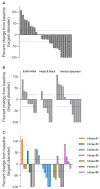Calcium Electroporation of Equine Sarcoids
- PMID: 32204512
- PMCID: PMC7143334
- DOI: 10.3390/ani10030517
Calcium Electroporation of Equine Sarcoids
Abstract
Sarcoids are common equine skin tumors where the risk of recurrence after treatment is high, and better treatment options are warranted. Calcium electroporation is a novel anti-cancer treatment where lethally high calcium concentrations are introduced into the cells by electroporation, a method where short high-voltage pulses induce transient permeabilization of the cell membrane. This study investigated the safety and long-term response of calcium electroporation on sarcoids. Thirty-two sarcoids in eight horses were included. The study suggested that calcium electroporation is a safe and feasible treatment for sarcoids, including inoperable sarcoids. Horses were treated once (2/8) or twice (6/8) under general anesthesia, where sarcoids were injected with 220 mM calcium chloride followed by electroporation with 8 pulses of 100 μs, 1 kV/cm, and 1 Hz. Biopsies were taken prior to treatment. The sarcoid size was monitored for 12-38 weeks after the first treatment. Complete response was observed in 22% (6/27) of treated sarcoids, and partial response in 22% (6/27), giving a 44% total response. Treatment efficacy did not appear to be related to location, type, or size. In all non-biopsied lesions, a complete response was seen (4/4). In conclusion, in this small study, 44% of sarcoids responded with 22% of sarcoids disappearing.
Keywords: biopsy; calcium electroporation; equine; horse; response; sarcoid.
Conflict of interest statement
A patent, “Therapeutic applications of calcium electroporation to effectively induce tumor necrosis”, has been granted and licensed (co-inventors S.K. Frandsen and J. Gehl). The sponsors had no role in the design, execution, interpretation, or writing of the study.
Figures






References
-
- Taylor S., Haldorson G. A review of equine sarcoid. Equine Vet. Educ. 2013;25:210–216. doi: 10.1111/j.2042-3292.2012.00411.x. - DOI
-
- Falk H., Matthiessen L.W., Wooler G., Gehl J. Calcium electroporation for treatment of cutaneous metastases; a randomized double-blinded phase II study, comparing the effect of calcium electroporation with electrochemotherapy. Acta Oncol. 2017;57:311–319. doi: 10.1080/0284186X.2017.1355109. - DOI - PubMed
Grants and funding
LinkOut - more resources
Full Text Sources

